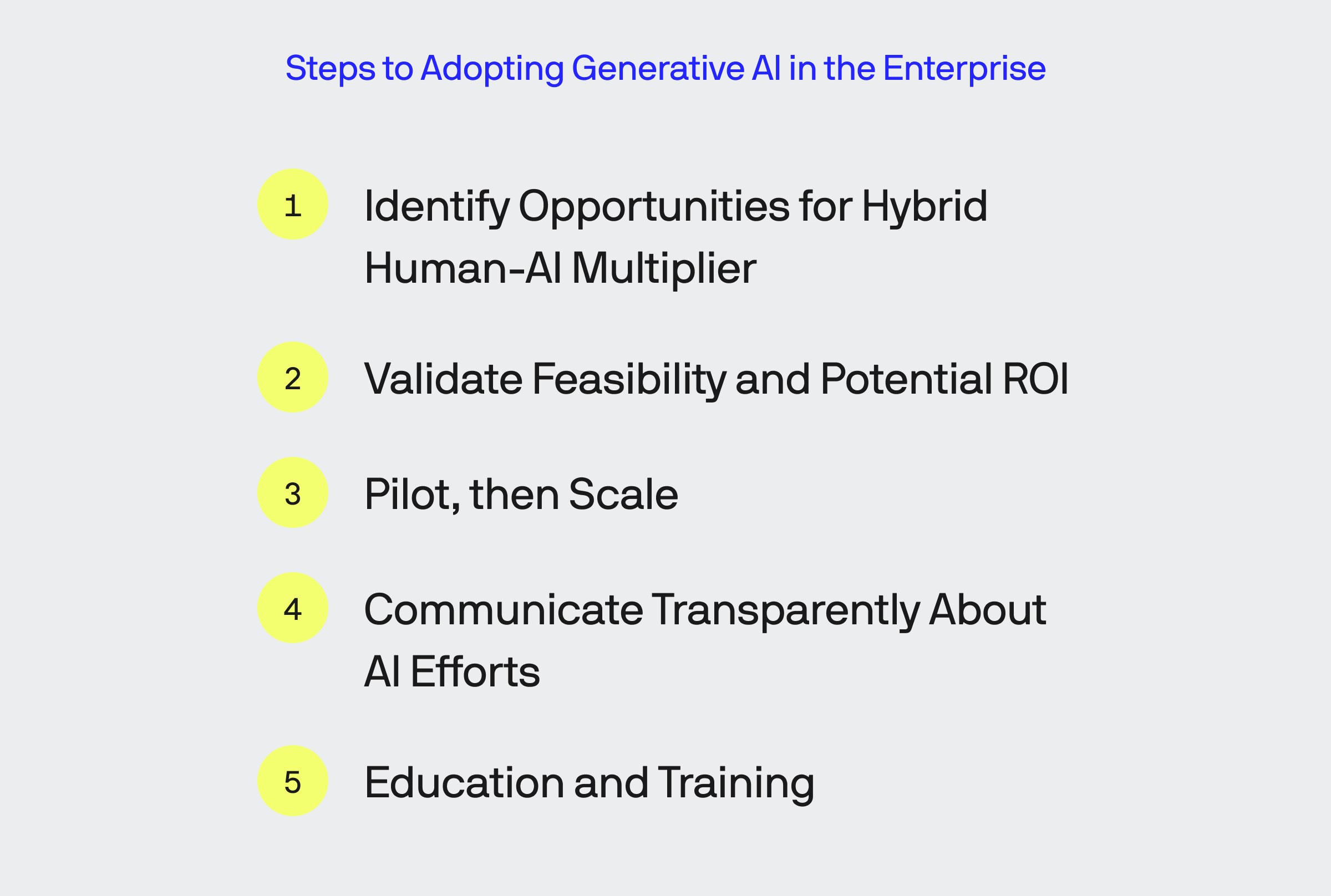A Guide to Adopting Generative AI in the Enterprise
Not since the rise of the Web in the early 1990s has the enterprise shuddered at the transformational potential of a new technology as it does today with the emergence of generative AI. This era, highlighted by advancements like ChatGPT, DALL-E, and LLaMa is opening up a realm of possibility for redefining economic and societal frameworks. For enterprises, especially at the leadership level, the possibilities of leveraging generative AI is an opportunity not just for competitive advantage but for profound digital transformation that can multiple revenue while whittling away at costs.
In this article, I will examine the following:
- Define the enterprise context of generative AI through the concept of ‘hybrid human-AI workflows’.
- Provide real-world examples of enterprises BlueLabel has worked with who have adopted generative AI through these hybrid workflows.
- Outline the potential steps an enterprise can take to assessing, piloting and deploying generative AI-powered hybrid human-AI workflow.
Introducing ‘Hybrid Human – AI Workflows’
Integrating generative AI into your team isn’t meant to replace a human, or function as a software package that is typically deployed. Instead, generative AI’s adoption in the enterprise is driven through what we at BlueLabel call ‘hybrid human-AI workflows’. This approach does not diminish the importance of human talent; rather, it enhances it by introducing the use of generative AI tools at discrete points of a nominally human backed workflow. For instance, when performing data analysis on a financial model in Excel, instead of a human attempting to perform that analysis using macros or PivotTables, they could use ChatGPT’s data analysis tools to have the AI automatically perform this analysis and then interpret the results for them. That tool already exists, the employees just needs to know how to interact with it via ‘prompts’ to leverage ChatGPT as its assistant in completing their analysis.
An important axiom to remember when approaching generative AI in your company is that it is less a software development problem, and more so one of tooling, training and process optimization. While there may be some component of custom development when attempting to integrate generative AI into your existing workflows, however it is not essential. More likely than not, you can unlock the productivity benefits of hybrid human-AI workflows by adopting technology that is already available and training your workforce on how to use it.
Hybrid Human-AI Workflows in Action
At BlueLabel, we’ve worked with a number of our clients to help them pilot and deploy hybrid human-AI workflows across a range functions and as stepping stones to more broader adoption of generative AI in their respective companies. Here are some examples of hybrid human-AI workflows we’ve helped our enterprise clients pilot:
Enable Self-Service Support via a Generative AI-Powered Enterprise Chatbot
With one of our enterprise clients, they struggled to maintain an up-to-date knowledge base of documents, support logs and specifications to support their field operations team. Ultimately, most field issues needed to be resolved through the manual intervention of a human via a Zendesk ticket. Our BlueLabel team realized quickly that a ton of product specification and tribal knowledge was locked up within two data silos: the company’s JIRA (where all product specifications were recorded) and their Zendesk ticket repository. Further, we saw that both of these data stores, when combined with a LLM atop of it, could power a self-service chatbot. We were able to create a self-service chatbot that leveraged Retrieval Augmented Generation techniques to answer 80% of field operations queries automatically without requiring any human or Zendesk ticket to be created. The amount of custom code needed to create this chatbot was comparable to that of a regular single paged application (SPA) written in ReactJS.
Boost Developer Productivity 10x through Coding Assistants
Another example where BlueLabel has helped its clients unlock the productivity boost of hybrid human-AI workflows is in the writing of programming code. Note, I said ‘code’ and not ‘software’, as a common misunderstanding people have is that generative AI can write software for you, which is flat out wrong. Building software is still a specialized, highly-skilled craft that requires the mind of a software engineer. However, producing the exact lines of code, in the particular language needed for a software development task is one where tools such as Github Copilot and DeepSeek Coder can almost completely take over. With one of our clients, through simple instruction of how to integrate Copilot into their developer’s tooling and the use of specialized LLMs such as DeepSeek Coder, we were able to easily 10x the productivity of their engineers by allowing them to support software written across a number of different languages. Previously, each language would have required an engineer trained to use that language, however, with generative AI, a software developer can speak the near universal language of computation in English and have the code that implements it created for them. Adopting this solution for our client required a few training classes and install scripts, the rest came out of the box!
A Guide to Adopting Generative AI in the Enterprise
With a rapidly evolving technological landscape that is propelled by seemingly endless hype, it can be overwhelming to know where to begin. Most of the companies we’ve worked with come to us knowing they need to adopt generative AI, but having no idea of where to begin. Based on our work with a number of enterprise clients, here is a simple framework we use to help guide enterprises in creating their first hybrid human-AI workflows using generative AI.

Identify Opportunities for Hybrid Human-AI Multipliers
Once you understand what AI is and what it can generally do, the first step to bringing it to life in a business is to look at your organization’s core operational processes, specifically those which are labor intensive, repetitive or involve customer touch points. We’ve seen great disruption in the spaces of content generation and marketing, customer service, visual design, and knowledge management and training in the current wave of generative AI, these are the first places to look. A good starting point might be to engage with front-line employees to try to understand processes which could benefit from AI, they will know the parts of their job that bog them down and where existing tooling is not able to help them.
Validate Feasibility and Potential ROI
The hype in AI makes it hard to know whether the processes you’ve identified really can be done with AI? Much like the web in the late 1990s, their is a lot of potential with AI, and a lot of claims made about what it can do, however the reality is that there is still a considerable delta between what is promised and what actually can be practically achieved.
Even if they can be, is the ROI worth it? While it’s critical you and your team have a general understanding of what generative AI is, it is not realistic to expect that you will be in a position to understand how to bring to bear the rapid swath of AI tooling being developed to your problem space in a reasonable amount of time. Look to bring in expert help to augment your teams and develop an implementation strategy. This can be in the form of full-time employees, consultants, or firms, such as BlueLabel, that specialize in AI adoption.
Pilot, Iterate and then Scale
Unlike traditional software development, it is very hard to predict how well an AI-enabled workflow will work until you actually put them in practice. There is little determinism when it comes to generative AI: asking the same thing twice to an AI might likely yield two completely different results. Do not go into full scale development or pivot entire operations until you are able to pilot a hybrid human-AI workflow in a controlled setting. For instance, if you are looking to automate a content creation pipeline with AI, a good way to approach this is to pilot the effort by assigning certain blog posts or newsletters in your content calendar as being those to be done with the assistance of an AI tool.
For example, in our internal customer service chatbot example, we initially started with a goal of creating a self-service support bot for both customers and field operations. However, we saw very quickly that while we could very quickly build a powerful chatbot that answered most questions thrown its way, it was very difficult to prevent it from disclosing internal IP or confidential knowledge that should not be shared outside of the enterprise. Hence, we decided to not allow customer access to the chatbot and instead focused on only allowing internal employees to use it, which still delivered exceptional value.
Communicate Transparently About AI Efforts
There’s great unease about the potential implications to the labor force from the emergence of AI. It is critical that as part of any AI initiative you communicate transparently with your managers and employees about what an AI implementation will actually bring to their working environment. There is a tendency to view AI as something that will put people out of work and something to be afraid of. However, while that may be the case, it is more likely that AI initiatives will actually improve the day to day work of employees as a hybrid human-AI workflow allows existing employees to maximize their productivity and to offload often grueling and tedious tasks to an AI. It’s important to demo early how AI works and what it is capable of so employees can begin to appreciate the net benefit to their work it might bring.
Educate and Train
There is no point in attempting to use a generative AI tool in your workplace if nobody knows how to properly use it. When it comes to working with AI tools, employees need to understand how to properly work with it. From learning the basics to ‘prompt engineering’, to understanding how to converse with an AI over multiple prompts to yield a desired result, we’ve found the greatest benefit of generative AI is unlocked only when people spend the time to learn how to properly work with it.
Conclusion
As we close this guide on adopting generative AI in the enterprise, it’s essential to reflect on the transformative journey ahead. The advent of generative AI marks a pivotal moment in the history of technological innovation, akin to the early days of the internet, promising to redefine the way we work, create, and solve problems. By embracing hybrid human-AI workflows, organizations can unlock unprecedented levels of efficiency, creativity, and innovation, turning the challenges of today into the opportunities of tomorrow.
The path forward requires a strategic approach, grounded in a deep understanding of your organization’s unique needs and potential AI applications. It’s about leveraging AI not as a replacement for human talent but as a powerful tool to augment and enhance it. By identifying key areas for AI integration, validating feasibility, and implementing pilots, enterprises can pave the way for scalable, impactful AI solutions.
Bobby Gill









